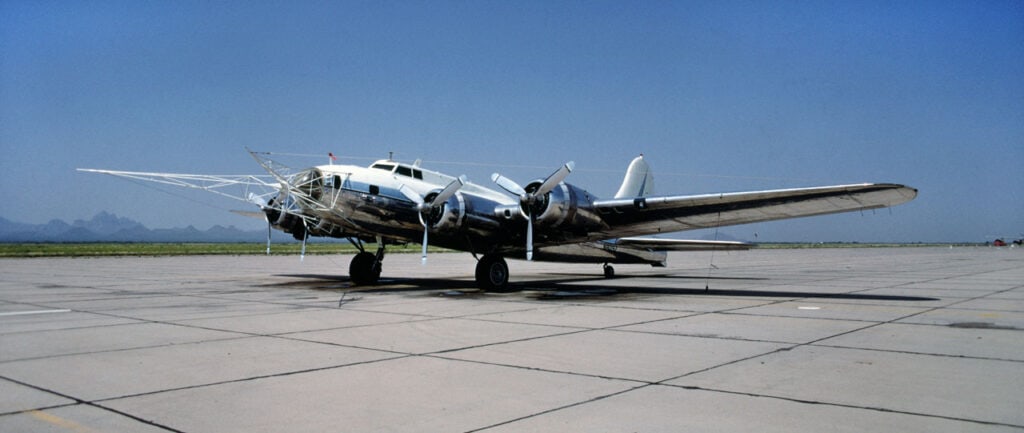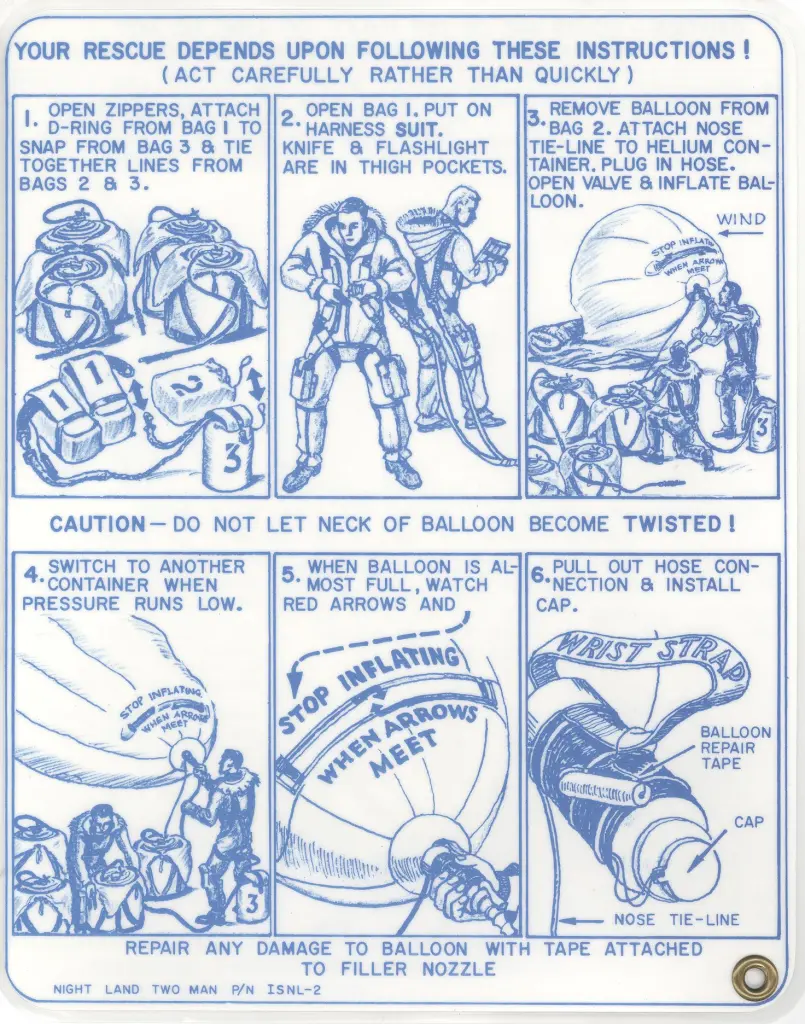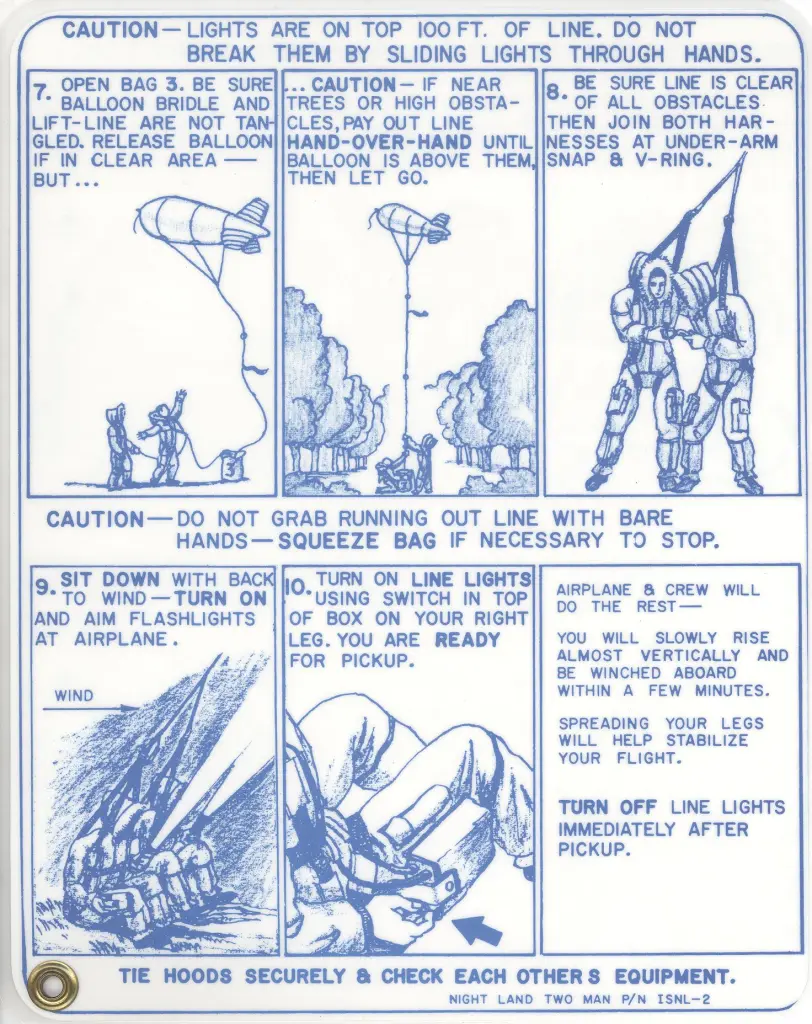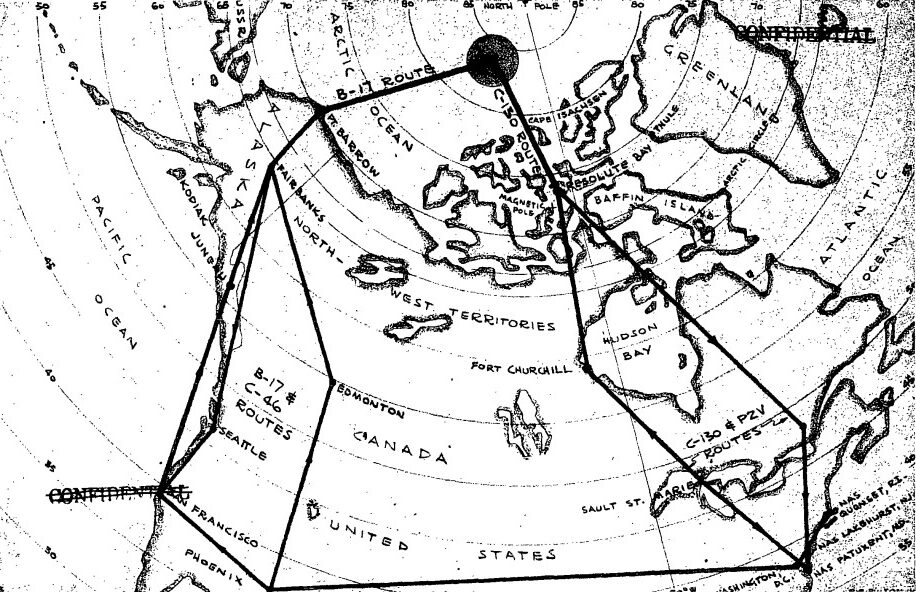Known colloquially as Skyhook, the Fulton surface-to-air Recovery System is a system where slow-moving fixed-wing aircraft capture loads on the ground (source). These loads included both inanimate objects and individuals (source). However, personnel recovery was the system’s primary use (source).
1.0. What is the Fulton surface-to-air Recovery System?
The Cold War promoted the invention and dissemination of highly experimental systems to gain an edge over opponents. Many of these, from a modern perspective, seem absurd and impractical. However, they were an important stopgap while more advanced technology was still in the works. One such system is the Fulton surface-to-air Recovery System, which must be explained to be believed.
1.1. How does it work?
Cargo (human or otherwise) would hook into a system composed of a wire and a balloon. (source). This balloon, upon inflation, would lift the wire into the air (source). A specially modified aircraft would fly above at a constant low speed and lock it into place upon meeting the suspended wire (source). The aircraft would immediately pitch up upon capture to suspend the load (source). Individuals extracting using this method would experience 7 Gs as they were lifted into the air at 200kmh (125 mph) (source). While uncomfortable, this is relatively safe (source). Finally, the aircrew would reel in the load once fully secured (source). This whole process took approximately six minutes (source).
1.2. Components of the Fulton surface-to-air Recovery System
The Skyhook system consisted of two or three parts, depending on the load in question. A wire attached to a balloon was necessary for all circumstances (source). Operators inflated the balloon using pressurized Helium tanks (source). The wire was a braided nylon capable of lifting 1800kg (4000 lbs) into the air (source). Personnel recovery necessitated specially designed harnesses (source).
As noted before, the unique nature of this system necessitated specially modified aircraft. These aircraft included the MC-130 Talon I (a variant of the C-130), B-17s, and a host of others (source). Due to low stall speed, propellor-driven aircraft were preferable. The sky anchor, which allows for the capture of loads, is located on the nose of the plane (source). It comprises two steel tubes spread at 70-degree angles relative to the nose (source).

1.3. A Brief Review of the Recovery Process
- Proper securing of cargo: Both people and objects need the proper equipment to enable recovery. For personnel, overall harnesses were issued, which came already connected to the wire and balloon (source). The center of mass of an object is where the wire and balloon would be attached (source).
- Balloon inflation: The balloon would be inflated, reaching an altitude of 150m (500 ft) above the ground (source). This would suspend the nylon wire in mid-air (source).
- Preparing for pickup on the ground: Personnel would sit on the ground with their back to the wind (source). At the same time, they would shine flashlights at approaching aircraft to help guide them (source).
- Preparing for pickup in the air: Pilots would make several preparatory passes over the cargo to determine the optimal approach route (source). Upon choosing a route, the aircraft would approach at low speeds, aiming for an orange indicator 130m (425ft) up the length of the rope (source).
- Pickup and recovery: Upon contact with the wire, the sky anchor would lock loads into place to prevent dangerous oscillation (source). The aircraft would immediately pitch up, which would cause the wire to trail under the aircraft (source). Aircrew would collect the wire, attach it to a winch system, and reel it in aboard the aircraft (source).


2.0. History of the Skyhook
Mid-air recovery has its roots in the 1920s. All American Aviation pioneered a method that placed a load of mail between a pair of poles (source). A wire would be suspended between the bars and attached to the cargo (source). An aircraft flying perpendicular to the rods would approach at 150kmh (90 mph), towing a steel cable with a grappling hook (source). Upon contact with the suspended wire, the aircraft would pitch up (source). Shock absorbers cushioned the force generated, and the aircrew winched in the package (source).
During World War II, the Western Allies discovered the need to quickly recover men and material from the air (source). The system created by All American Aviation was utilised (source). Great Britain and the US recovered gliders and personnel using this method, proving its utility in military and espionage contexts (source).
2.1. Post-War Experiments
The war’s end did not spell the end of the idea of mid-air retrieval. The CIA and Air Force continued experimenting with the concept (source). The CIA used the All-American method during the Korean War to recover men and materials used to establish resistance networks in Manchuria (source). In 1950, inventor Robert Edison Fulton Jr. began independently refining this process (source). He started using weather balloons to suspend a nylon wire rather than relying on pairs of poles (source). Fulton ran several experiments before ultimately capturing a lightweight load (source). He sent photographic evidence of this to Luis de Florez, the director of technical research at the CIA (source). From here, the Office of Naval Research reached out to Fulton (source). He quickly received a contract to develop the system further (source).
2.2. Development and Refinement
Fulton began work in El Centro, California, in 1950 (source). Utilising a Navy PV-2 Neptune, he flew over the Colorado Desert to further experiment with his new system (source). Development was slow and difficult. Fulton identified two issues; the composition of the line to prevent breakage and anchoring the cord to avoid dangerous movement by the captured object. Testing showed that braided nylon with high tensile strength was the optimal material to use (source). The sky anchor design would funnel the line to a central point, after which it would be locked into place (source). The line would run under the aircraft following successful anchoring, and the crew would secure and reel in the load (source). According to Fulton, the design of the sky anchor was the most challenging part of the systems development (source).
2.3. Testing
Testing initially began with dummies (source). When these proved successful, tests began using live subjects. The first of these was a pig (source). Unfortunately for this pig, it began to spin wildly upon capture as the aircrew reeled it into the aircraft (source). While still safe, this development disoriented the load substantially (source). The first human trials in 1958 would solve this problem (source). USMC Staff Sergeant Levi Woods successfully recovered using Skyhook (source). He avoided disorientation by spreading out his arms and legs while reeling in (source). Following this, testing moved to Eglin Air Force Base, Florida, on the 1st of August 1959 (source). Here the project was finalized and named after its creator.
3.0. Operation Coldfeet
In 1960, Skyhook recovered archaeological and geological samples from remote locations in Alaska (source). While undoubtedly useful, a CIA operation in the Arctic circle would reveal the actual utility of the system.
3.1. Context
In May 1961, US Navy aircraft out on survey duty spotted the abandoned Soviet drift station NP 9 (source). Both sides of the Cold War established drift stations to research Arctic conditions (source). As isolated research based on movement-capable ice, both powers routinely abandoned them due to environmental conditions (source). The CIA spotted an opportunity in this abandoned station. If they could explore the abandoned structure, they could ascertain valuable intelligence about Soviet scientific and military capabilities (source). Preparations soon began to find a way onto the drifting ice (source).
3.2. Why Skyhook?
The distance made helicopter transport impossible, and its location deep within the Arctic ice sheet made the approach by icebreakers nonviable (source). The Fulton surface-to-air Recovery System was the only option to promptly recover personnel sent on the mission. The CIA slated the operation to begin in September (source).

3.2. Selecting the Investigators
Two men were selected for the operation. Major James Smith of the USAF was a decorated paratrooper who had also served on US drift stations in the Arctic (source). Moreover, he had a background as a Russian linguist (source). Lieutenant Leonard A. LeSchack of the US Navy Reserve was an Antarctic geophysicist who had likewise helped establish listening posts in the Arctic (source). LeSchack was put through a jump course at Lakehurst Naval Air Station to get him jump-qualified (source). Following this, the men trained extensively on Skyhook throughout the summer (source).
3.3. Bureaucratic Delays
At the top of the Navy hierarchy, mission planners were experiencing issues convincing officials of the utility of the operation (source). Belatedly, opponents gave the green light to Operation Coldfeet, but only in late September (source). This delay substantially delayed the cold weather testing of Skyhook. Furthermore, this testing revealed flaws within the existing design that had to be accounted for (source). The CIA put the project on hold until the Spring of 1962 (source).
3.4. A Change of Plans
In March, the CIA received information that an additional Soviet drift station had been abandoned (source). NP 8 station had more advanced equipment than NP 9 and thus was a valuable target (source). On the 4th of May 1962, American aircraft performing a reconnaissance flight spotted NP 8 (source). The mission objective officially changed following this discovery (source).
3.5. The Operation
On the 28th of May, Smith and LeSchack parachuted onto NP 8 (source). They had 72 hours to explore the base, collect documents and take photographs (source). By this metric, the operation was a resounding success. Intelligence gathered by the men allowed analysts to determine that Soviet drift stations were capable of silent operation for extended periods (source). The Soviets clearly understood the value of acoustical work in the Arctic (source). It also implied that Soviet drift stations could function as listening posts (source). Additionally, the operation showed that Soviet Arctic environmental research was more advanced than that in the West (source). The operation gathered 68kg (150 lbs) of documents, films, and samples (source).
3.6. Recovery
The pickup of Smith and LeSchack was delayed by a day due to poor visibility, as spotter planes could not find NP 8 (source). On the 1st of June, US aircraft spotted the drift station, and recovery efforts were initiated (source). The weather remained poor, and conditions at the surface were not ideal for Skyhook. The wind was blowing at 30 knots (source). After inflating their balloons, both men were dragged across the ice until they stopped their movement with natural barriers (source). Fortunately, the pickups went off without further issues. The modified B-17 made three passes to collect the party, first for the cargo, then one pass each for the investigators (source).

3.7. Operational Success
More than providing valuable intelligence, Operation Coldfeet demonstrated the utility of the Fulton surface-to-air Recovery System (source). Even in sub-optimal conditions, the pickup’s success proved that Skyhook could reach and conduct intelligence operations in traditionally inaccessible areas (source).
4.0. Falling out of Favor
Despite the success of Operation Coldfeet, the development of long-range helicopters and mid-air refueling spelled the end of Skyhook as a critical system (source). In the 1960s, new helicopters such as the Sikorsky HH-3E Jolly Green Giant and the Boeing CH-47 Chinook took over the role of personnel recovery in hostile territory (source). The HH-3E, for example, was capable of flying nonstop from New York to Paris (source). Skyhook-modified aircraft remained in US inventories until 1996, after which they were mothballed or placed into storage (source).
5.0. Conclusion
The Fulton ground-to-air Recovery System is an incredibly unique concept, made for a special place in time. Although helicopters have replaced its modern-day utility, Skyhook is still a fascinating glimpse of the tradecraft of the era. Popular culture has used the system in a variety of projects. The 2008 film The Dark Knight features a Skyhook extraction from Hong Kong (source). Metal Gear Solid V and PlayerUnknown’s Battlegrounds feature Skyhook as a gameplay mechanic (source).

